"I Don't Have to Show You Any Stinkin' Software"
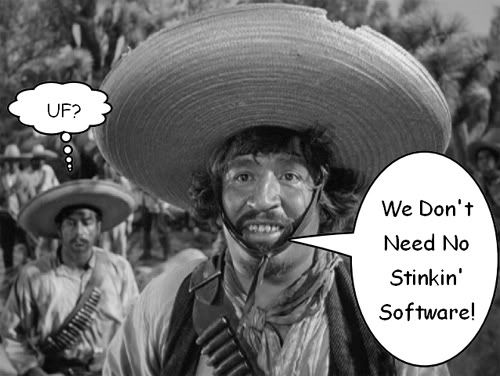
If you're the fractal police, where is your software?
Aaah, leave it to the cutting edge crowd over at Keith MacKay's idreamincolor forum to ask the big questions and come up with the big-headed answers.
Over a month ago, MacKay posited this head-scratcher:
Lately I have been wondering if we have seen everything that fractal art has to offer. Sometimes I wonder if there nothing new to be seen in a fractal. Is everything just a variation of something that has already been created?
In this thread I would like to see examples of what you consider to be new or unusual in fractal art. What do you think?
And the results poured in. Well, sort of. Two people answered. Apparently, the idea of actually doing something new -- or even finding something new -- never occurred to any of the other forum members.
The first responder found plenty of groundbreaking new work. In fact, he cited and linked to no less than fifteen images ... ten of which were his own. Talk about product placement. This reminds me of a certain somebody who was put in charge of a certain somebody else's vice-presidential exploration committee -- and ended up choosing himself.
The second responder never really addressed MacKay's question. She preferred instead to go on a tear against the "fractal police of dA [deviantART]" for not accepting her melded fractals with non-fractal materials (read: photos) into that community's fractal art repository.
The two responses, however, did have one thing in common -- of course. Ultra Fractal. Obviously, to them anyway, UF is the only option for pursuing the "new and unusual." The first responder cited its availability of new formulas (written by him?). The second responder swooned over the profound possibilities of UF5's image import feature. And there, Orbit Trappers, in a self-similar nutshell, lies the future of fractal art.
I could point out that new formulas are always being added to UF -- in much the same way new filters are always being created for Photoshop -- so this is really only an ongoing evolution of already existing features. I could further point out that graphics programs like Photoshop have allowed artists to import photos and layer them into fractals for at least over ten years -- that is, if one wanted to dirty one's artistic soul with the heinous offense of (dare we speak its name?) post-processing. I could even go so far as to point out that I argued in an earlier OT post that communities like deviantART and Renderosity should question whether "fractals" made with UF5 imported photos are actually mixed-media creations and should properly be placed in more appropriate galleries. I could point all of this out, but none of these observations would address the real question raised. That is: what, indeed, represents the shock of the new?
Like the Shadow, the respondents know. UF must the sole tool of the next new wave.
If so, all of us will soon nod out as we succumb to a mass theta state. Repeat after me: same as it ever was.
Seriously, if MacKay really wants to "think outside the box" as he says in a recent blog post, then he and his certain blogging friend might start by throwing that box away and getting rid of UF entirely. In fact, maybe both of them should try making fractal art without using any software at all.
~/~
As I pointed out in my last post, many artists are making some kind of "fractal art" without relying much, if at all, on using software. Rose Rushbrooke produces amazing fractal quilts -- as do other artists like Diana Venters and Elaine Ellison. Eleanor Kent's tools are fabric and photocopiers. Lesley Kice builds textile-based installations that demonstrate fractal characteristics. Fractal art should be broadened to include much more than images manufactured in a generator like UF. And, perhaps, such out-of-the-box examples might serve as a good place to start looking for something "new and unusual."
To try and include every example would be overwhelming, so, for the sake of discussion, I've decided to limit this post to a few cases that probably fall under the general area of sculpture.

Fractal Table by Wertel Oberfell with Matthias Bär
This is an installation piece that grew out of studies of fractal growth patterns. It is extremely detailed. To see other views of the Fractal Table, including the intricate table top, go here. Does the concept of translating fractals into furniture have potential? I think so, although I'm holding out for a discount deep zoom sleeper sofa.
Why settle for a simple OPEN sign when you can have lit-up complex mathematics instead? I suspect true Hilbert neons would require an infinite amount of tubing, and, really, who has that much space in their rec room? Still, if you have a spare $500, you can own this:
Our sculpture is the level-2 Hilbert fractal, which for 3-dimensional space means 2^6 = 64 vertices. The neon run thus passes through 64 lattice points. Notice the beautiful properties that a) each short run of the Hilbert fractal is straight, b) each run goes in an ortho-direction (x, y, or z direction exclusively), and c) the fractal starts and ends at the sculpture's base, allowing for elegant mounting.
Now if they would just attach a beer logo to it...
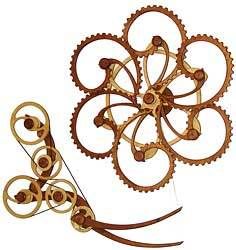
Roy makes wood-based kinetic sculptures put into motion by springs and pulleys. The one above, named by his daughter, certainly displays remarkable self-similarity -- especially when set into motion (see a flash animation here). This particular one will run for 16 hours and is limited to an edition of 9. It will only set you back $3200 -- plus the exertion of starting it. About the design, Roy notes:
The Variation series is the result of my continued exploration in the world of kinetic patterns created by 6 overlapping wheels that orbit a common center. Each orbiting form is designed to hold a particular orientation by rotating in the opposite direction from its orbital motion.
Although Roy states that he wasn't thinking about fractals when he made this piece, a surprising number of his sculptures seem very fractal in their designs.
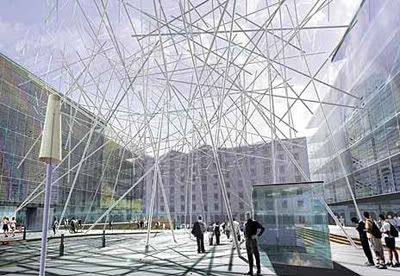
Design Sketch for "Fractal Cloud" by Miguel Chevalier with Charlie Bové
"Fractal Cloud" is a massive sculpture slated for the dockland area of Marseille and created as part of a public commission. It consists of a complex web of optical fiber cables. The cables change color every hour and appear metallic in daylight. By night, however, the sculpture is illuminated with colored projectors and (according to the artist) "works as an astronomical clock." What makes it fractal-like? Chevalier explains:
The fractal cloud multiplies itself infinitely in a network and a play on scale that breaks with classical perspective and Euclidean geometry.
Look at the human figures in the picture above to try to imagine the scale of this piece. There are more images of the proposed installation here.
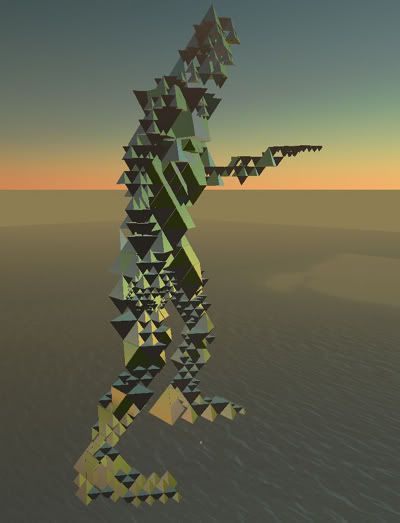
Segerman created this object and scripted it to navigate through Second Life, the gigantic, multi-player, online world. In addition to this figurative sculpture, Segerman has created many other fractal objects for Second Life, including fractal trees, hypercubes, and (my favorite) a "Fibonacci Pinecone."
This is fractal art made for a world other than our own. So, to MacKay and his friends, I ask: Is this work outside the box enough for you?
This post covers only one software-less area of fractal art. I imagine I could just as easily put together a similar post in other areas like ceramics and fiber art. So, the next time someone tries to buffalo you by pointing out that a for-engineers-only program like UF is the end-all wave of the future, forcefully remind them that you don't need no stinkin' software.
Tags: fractal, fractals, fractal art, digital art, stinkin' software, ultra fractal, treasure of the fractalbooking madre, keith mackay, werter oberfell, perfectly scientific, david c roy, miguel chevalier, henry segerman, second life, cruelanimal, orbit trap
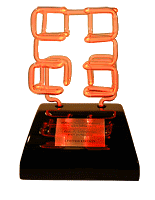




2 Comments:
For more artwork (mathematically-inclined, but not necessarily fractal) that is not output from a 2D program, check out the mathematical art and sculptures blog.
9/24/2008 3:18 PM
On non-software-generated fractals, check out: 10000 peacocks foaming in acid.
On the subject of how terrible UltraFractal is: yawn. Find another horse to beat, this one's dead.
9/25/2008 12:14 PM
Post a Comment
<< Home